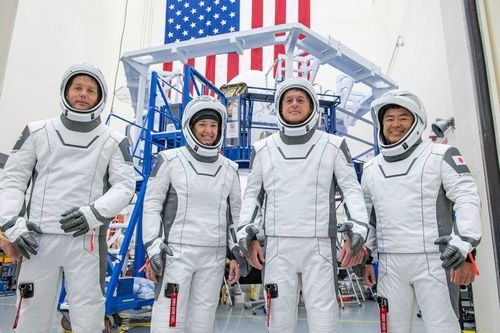SpaceX is sending a capsule back to space, this time with different astronauts

Four astronauts from three countries are preparing to leave Earth this week aboard a SpaceX Crew Dragon capsule, marking the third-ever crewed flight for Elon Musk’s company, and the first from SpaceX to make use of a previously flown rocket booster and spacecraft.
Friday’s SpaceX launch will make use of the same rocket booster that powered the 2020 Demo-2 mission, as well as the same spacecraft, dubbed “Endeavour.” SpaceX has long made reusability a cornerstone of its business plan, hoping that recovering and refurbishing hardware will drive down the cost of spaceflight. Though the company has re-flown boosters and spacecraft dozens of times on satellite and cargo launches over the past several years, this will mark the first time the company will reuse hardware for a crewed mission.
NASA astronauts Shane Kimbrough and Megan McArthur will be joined by French astronaut Thomas Pesquet of the European Space Agency, and Akihiko Hoshide from Japan. They’ll spend six months aboard the International Space Station after their Crew Dragon capsule docks early Saturday morning.
The journey is slated to begin at Kennedy Space Center in Florida on Friday, when they’ll board the capsule atop one of SpaceX’s 200-foot-tall Falcon 9 rockets. And, if looming thunderstorms don’t intervene, the rocket will take off at 5:49 am ET.
The astronauts’ Crew Dragon will separate from the rocket shortly after reaching Earth’s orbit — traveling at speeds topping 17,000 miles per hour — and the crew will spend nearly a full day aboard the spacecraft as it slowly maneuvers toward the 21-year-old International Space Station, which orbits about 250 miles above ground.
The Crew Dragon is expected to dock with the ISS around 5:10 am ET Saturday.
Kimbrough, McArthur, Pesquet, and Hoshide will join seven astronauts already on board the station, four of whom arrived on a different SpaceX Crew Dragon capsule in November. That’ll put the space station’s total staff at 11 — one of the largest crews the ISS has ever hosted. But that number will quickly drop back down to seven when four other astronauts hitch a ride home from the station on April 28.
NASA has spent more than a decade working to boost staffing aboard the 21-year-old space station after the retirement of its Space Shuttle program in 2011 left Russia’s Soyuz spacecraft as the only option for getting astronauts to and from the ISS. The United States had been paying Russia as much as $90 million per seat for those trips.
For years, SpaceX worked under a $2.6 billion fixed-price contract to develop its Crew Dragon spacecraft under NASA’s Commercial Crew program, which for the first time in space agency history handed over the task of building and testing a crew-worthy spacecraft to the private sector. SpaceX made history last May with the first crewed launch of a Crew Dragon on a mission called Demo-2, which carried NASA astronauts Douglas Hurley and Robert Behnken to the ISS for a four-month stay. A second crewed SpaceX mission took off in November.
(Boeing is working under a similar contract to develop its own capsule for the program, called Starliner, though it is still in the testing phase.)
A prime focus of the astronauts’ mission will be to study “tissue chips,” or “small models of human organs containing multiple cell types that behave much the same as they do in the body” and that NASA hopes will advance the development of drugs and vaccines, according to the space agency. That work will build on years of studying biological and other scientific phenomena aboard the ISS, where the microgravity environment can give scientists a better fundamental understanding of how something works.
McArthur is a Space Shuttle veteran and is married to Behnken, who co-piloted SpaceX’s historic Demo-2 mission last May. McArthur told reporters over the weekend that she was able to get “years of experience” with the Crew Dragon vehicle as Behnken worked alongside SpaceX during the Crew Dragon development process.
“I had several years, really, of learning from him along the way,” McArthur, who will pilot the Crew-2 mission and holds a doctorate in oceanography, said.
McArthur will be joined by NASA’s Kimbrough, a retired Army colonel and a veteran of two previous ISS missions. Their crewmates, Japan’s Hoshide and France’s Pesquet, both have prior spaceflight experience as well.
Pesquet said he appreciated the chance to fly aboard the refurbished rocket booster that helps lift the capsule into the void. The weathered hardware still covered in soot from their prior flights, allowed him and his crewmates to to “draw our initials” on the side of the vehicle.
“I don’t know if [the writing] is gonna stick, but I’ve found it really cool,” he said.